Thursday, October 30, 2008
Late October at Maggie's Farm
Soup

Lentil soup with onions and garlic. Carrot-parsnip soup with honey and fresh cream. Cauliflower and cheddar soup. Spicy vegetable soup with potatoes and carrots. Pureed root soup with cheddar cheese. Potato-leek soup. French onion soup with crusty bread and good cheese.
My diet these past few weeks has been mostly soup. This week I've had soup every day for lunch, and a couple nights for dinner, as well. Not only is it easy and endlessly variable, but there is something absolutley essential about coming in from the cold every afternoon to a house scented with the rich steam of hot broth, garlic, and onions. After a morning of working muscles, wind-blown faces, dirt-encrusted hands, and the weathered handles of forks and shovels, there is nothing better than a bowl of heart and bone-warming soup.
Lunch at Maggie's Farm is a communal endeavor. Every day one or two people are responsible for making lunch for the whole crew. Though there are no formal rules about it, we seem to have soup four days out of five. I never get sick of it. In the fall, it is one of the few things I want to eat: good soup, roasted roots, and greens are the mainstays of my diet.
I truly believe that good food, food that comes from earth you know, is an essential ingredient to health and happiness. Soup has been a huge part of my experience here. It sustains me and reenergizes me in the middle of the day, warms me inside and out, and connects me to the land where the vegetables and meat that go into the pot each day are grown.
I am trying to do big things with small details. Keeping the land healthy begins with reaping its bounties. Lives are made up of light on grass, familiar hands, frosty mornings, pots of soup. These are the things we touch and see and taste every day. They have a lot to teach us about how to live our lives, how to walk on the earth, how to communicate with other creatures. Even a bowl of steaming fall soup, seemingly unimportant, can become a catalyst of change.
Saturday, October 25, 2008
Grey Days...
Friday, October 24, 2008
Ten Reasons I Love Chores
1. Working through the twilight hours. Getting up when the eastern sky is still shadowed, walking out to the coop in the pasture as the gold grows on the horizon. The crescent moon still glowing in the sharp blue sky. Frost on the garden and the raspberry bushes, and my feet crunching over all that silver as I walk through the pasture. New sun that turns the still-orange trees crisp-edged shimmering. At the end of the day, dusk falling over the farm, the stillness the sun leaves behind as it slips away, the brisk wind and the sky deepening slowly into darkness.
 2. Talking to animals.
2. Talking to animals.
 3. The routine of it. My feet learning the quickest path between the three coops, my fingers becoming familiar with cow fencing, my eyes growing accustomed to counting sheep accurately as they graze. I like the way chores bracket my day. I like knowing there are creatures counting on me for food and water.
3. The routine of it. My feet learning the quickest path between the three coops, my fingers becoming familiar with cow fencing, my eyes growing accustomed to counting sheep accurately as they graze. I like the way chores bracket my day. I like knowing there are creatures counting on me for food and water.
 4. Simple hard work: carrying 40 pound bags of feed over my shoulder, pouring buckets of cold water into the cow's trough, breaking the ice off the chicken's waterers, shoveling half-frozen manure. Using my muscles.
4. Simple hard work: carrying 40 pound bags of feed over my shoulder, pouring buckets of cold water into the cow's trough, breaking the ice off the chicken's waterers, shoveling half-frozen manure. Using my muscles.
5. Well-earned exhaustion.
6. I love the level of detail that animal care requires. I love walking out to the coop each night, singing my way through the dusky pasture, to close the chickens safely away from foxes and coyotes. Going to check on the cows at noon, simply to make sure they have enough water and grass, pausing in my work to scratch PB, our sweetest cow, or tell a sheep a joke. I like being exact and careful and methodical.
 7. It is good and humbling to have regular contact with non-human creatures.
7. It is good and humbling to have regular contact with non-human creatures.
 8. Chores are simple and daily and routine-based. The hour I spend taking care of animals each morning and evening is a good hour to think. To work through the day, to iron out problems, to sing, to weave poems. Chores are quiet and meditative. Time to ease into the day, slow down, transition from sleep to work to the evening meal, to sleep.
8. Chores are simple and daily and routine-based. The hour I spend taking care of animals each morning and evening is a good hour to think. To work through the day, to iron out problems, to sing, to weave poems. Chores are quiet and meditative. Time to ease into the day, slow down, transition from sleep to work to the evening meal, to sleep.
 9. Being outside first thing in the morning. Feeling the wind on my face almost immediately after tumbling out of bed. Pulling on two pairs of socks, barn boots, my carharts, my work coat. Meeting the day as it comes.
9. Being outside first thing in the morning. Feeling the wind on my face almost immediately after tumbling out of bed. Pulling on two pairs of socks, barn boots, my carharts, my work coat. Meeting the day as it comes. 10. Coming inside afterwards. The warmth of the house steaming up my glasses. Hot tea and a hearty breakfast that I've earned by work. Sunlight pouring into the house. A glass of cider and a piece of apple pie on the porch in the dusk. A job well done.
10. Coming inside afterwards. The warmth of the house steaming up my glasses. Hot tea and a hearty breakfast that I've earned by work. Sunlight pouring into the house. A glass of cider and a piece of apple pie on the porch in the dusk. A job well done.
5. Well-earned exhaustion.
6. I love the level of detail that animal care requires. I love walking out to the coop each night, singing my way through the dusky pasture, to close the chickens safely away from foxes and coyotes. Going to check on the cows at noon, simply to make sure they have enough water and grass, pausing in my work to scratch PB, our sweetest cow, or tell a sheep a joke. I like being exact and careful and methodical.
Tuesday, October 21, 2008
Sunday, October 19, 2008
A Recipe for Planting Garlic
Planting garlic isn't hard. It takes the hard work of your hands and your back, muscles moving and working under the bright sun, the blue sky at your back, the earth heavy and close underneath your knees, dirt under your fingernails. It takes a morning of singing, your song woven together with the song of the high sun and the brisk air, the protective skin on each fat clove, the promise of future bounty.
Plant each clove 6-8 inches apart in two rows with about 10 inches between rows. Bury each clove up to 2 inches deep in the soil. Be careful not to pat down around the clove with your hand; if you do, you will compact the soil, halting circulation and drainage. Row by row, transform the field from a barren piece of soil into a bountiful stand of beautiful garlic. Plant with a friend or you'll get lonely and sweaty. It is important to notice textures and colors, to pay attention to the weight of each clove in your hand, to pause as the wind sweeps over your face, to notice the scent of the soil and the light on the grass.
When all the cloves are safely in their caves of dirt, lay a thick layer of straw over the whole field. Cover the beds and the paths, and make sure it is thick enough to keep out the sunlight and prevent weeds from germinating and chocking out the tender green shoots. By late afternoon, the field will be one shimmering, golden square, the fall sun illuminating the straw and the blue sky framing it, brightening the day. You will be tired, your muscles heavy with use, your arms studded with straw, dust coating your forehead. It is good to be tired.
As the sun dips behind the trees, lie down in the field with the last of the light. Feel the earth beating through the layer of straw. Lying in the field, all you can see is the sky above you, the streaks of light from the setting sun, the occasional dark bird flitting across your line of sight. Think about the life of a plant, emerging from darkness into all this brilliance, and growing up, up, up, always toward the sun. It is a remarkable perspective. Feel the earth touching your head, your neck, the small of your back, your shins, your feet. It is important to lie in the field and bless the garlic. It is a good way to end the day, so close to the dirt, on the same plane as the hundred of cloves you've just put into the ground.
The work of farming is so constant that it is easy to forget that farmers are merely shepherds, and that the true work happens deep under the ground and in the paper-thin green leaves, heedless of our fussing. "Though he works and worries, the farmer never reaches down to where the seed turns into summer. The earth grants." - Rilke.
It is a good practice to lie down in the field and feel the substance of that transformation in our bones.
Cow and Sheep Chores
Dairy Transformation
This week we had our first dairy transformation class. Every morning we get between 1 and 2 gallons of milk from Pride, which is way more than even ten people can drink. We're learning all about how to transform the good fresh milk into butter, yogurt, ice cream, and cheese.
Butter and yogurt are both extremely easy to make. The most important thing is to get good, fresh, and, if possible, raw milk. When milk is pasteurized, all of the beneficial, healthy bacteria, along with any potential pathogens, are killed. In yogurt and cheesemaking, this is especially important to realize, because most of the bacteria and cultures present in the milk that gives yogurt its natural flavor are destroyed. If you try to make yogurt at home with pasteurized or ultra-pasteurized milk, you will not have much success. Cheese is also affected by pasteurization - the wide range of texture, flavor, and consistency in cheese is partially due to the natural bacteria in the milk.
Raw milk is healthy and delicious, a whole, living food with many health benefits that are simply destroyed through pasteurization, which renders milk a dead food. Healthy, grass-fed cows, raised on pasture and milked in clean environments provide safe, healthy milk. Buying raw milk is a great way to support small dairies that often don't have the means to compete with the bigger farms, but that are practicing organic, sustainable grazing and raising healthy cows.
Check out the NOFA Massachusetts webpage on raw milk, along with a list of dairies in the state that sell it: http://www.nofamass.org/programs/organicdairy/rawmilk.php
For the enthusiastic home-dairy-maker, here are two easy recipes that don't take more than an hour (not including cooling time).
Homemade Butter

Method 1:
Take some fresh cream (preferably unpasteurized cream skimmed off the top of a gallon of milk, but good quality lightly pasteurized cream should also work), put it in a mason jar, and shake vigorously for 10-20 minutes, until the fat globules mass together into a yellow glob. This is a great workout!
Pour off the buttermilk (delicious in pancakes!), and begin to wash your butter. Put it on a plate, pour some cold water over it, and work it with your hands. Pour off the water, add more, and continue washing it until the water you pour off is completely clear. Add salt if desired, and eat with fresh bread. Yum!
Method 2:
Same as above, except use a food processor to agitate the butter.
Fresh Yogurt

Heat a half gallon of milk in a double boiler over medium heat until it reaches either 120 or 180 degrees F. (If you heat it to 120, you won't kill all the bacteria, so your yogurt will still be a living product, but it will be harder to get a good, thick consistency without adding some kind of thickener. If you want a thick yogurt, heat to 180.)
Take the milk off the heat and let it cool to 115 degrees F. This will take a while. Once cooled, mix in 5 Tbs. of pre-made yogurt and stir well. Once you have a batch of yogurt made, you can use it as your culture each time you want to make more. Pour the yogurt into a half gallon mason jar, wrap it in a blanket or towel, and let sit in a warm place for 6-8 hours. If you have a gas oven, put your yogurt on the bottom rack with the oven off but the pilot light off. A cooler also works well.
After 6 hours, take out your yogurt, and eat it with jam and maple syrup. Yum!
Butter and yogurt are both extremely easy to make. The most important thing is to get good, fresh, and, if possible, raw milk. When milk is pasteurized, all of the beneficial, healthy bacteria, along with any potential pathogens, are killed. In yogurt and cheesemaking, this is especially important to realize, because most of the bacteria and cultures present in the milk that gives yogurt its natural flavor are destroyed. If you try to make yogurt at home with pasteurized or ultra-pasteurized milk, you will not have much success. Cheese is also affected by pasteurization - the wide range of texture, flavor, and consistency in cheese is partially due to the natural bacteria in the milk.
Raw milk is healthy and delicious, a whole, living food with many health benefits that are simply destroyed through pasteurization, which renders milk a dead food. Healthy, grass-fed cows, raised on pasture and milked in clean environments provide safe, healthy milk. Buying raw milk is a great way to support small dairies that often don't have the means to compete with the bigger farms, but that are practicing organic, sustainable grazing and raising healthy cows.
Check out the NOFA Massachusetts webpage on raw milk, along with a list of dairies in the state that sell it: http://www.nofamass.org/programs/organicdairy/rawmilk.php
For the enthusiastic home-dairy-maker, here are two easy recipes that don't take more than an hour (not including cooling time).
Homemade Butter
Method 1:
Take some fresh cream (preferably unpasteurized cream skimmed off the top of a gallon of milk, but good quality lightly pasteurized cream should also work), put it in a mason jar, and shake vigorously for 10-20 minutes, until the fat globules mass together into a yellow glob. This is a great workout!
Pour off the buttermilk (delicious in pancakes!), and begin to wash your butter. Put it on a plate, pour some cold water over it, and work it with your hands. Pour off the water, add more, and continue washing it until the water you pour off is completely clear. Add salt if desired, and eat with fresh bread. Yum!
Method 2:
Same as above, except use a food processor to agitate the butter.
Fresh Yogurt
Heat a half gallon of milk in a double boiler over medium heat until it reaches either 120 or 180 degrees F. (If you heat it to 120, you won't kill all the bacteria, so your yogurt will still be a living product, but it will be harder to get a good, thick consistency without adding some kind of thickener. If you want a thick yogurt, heat to 180.)
Take the milk off the heat and let it cool to 115 degrees F. This will take a while. Once cooled, mix in 5 Tbs. of pre-made yogurt and stir well. Once you have a batch of yogurt made, you can use it as your culture each time you want to make more. Pour the yogurt into a half gallon mason jar, wrap it in a blanket or towel, and let sit in a warm place for 6-8 hours. If you have a gas oven, put your yogurt on the bottom rack with the oven off but the pilot light off. A cooler also works well.
After 6 hours, take out your yogurt, and eat it with jam and maple syrup. Yum!
Tuesday, October 14, 2008
A Bright October Day
Fall Brassicas. Long Mowing Field.
Long Mowing Field.
 Brussels Sprouts!
Brussels Sprouts!
 Gorgeous Carrots.
Gorgeous Carrots.
 A Patient Mama.
A Patient Mama.
 April.
April.
 Cold Frames.
Cold Frames.

The Barn and Two Trucks.
The Barn and Two Trucks.
Harvest
After two weeks of CSA harvest at the Farm School, here are some thoughts and observations:
A Question of Scale
The Farm School has a 150-person CSA, with two pickups, one in Cambridge and one in Watertown. Twice a week we drive the van into Boston to deliver 60+ 1/2 bushel waxed boxes full of produce. We grow on about 10 acres of cropland. The harvest is very familiar to me - a similar scale to what I did at Land's Sake. But the wash station is something new. In the lower bran, we have a walk in cooler where we store the boxes once they've been packed (the day before), a huge wash area with hoses, wash bins, root washing/draining tables, an egg processing station, and a drain system that often takes 8 hours to drain after a harvest day. It's a very efficient system, and it's been great getting to know it these past few harvest days. But it is also in the bottom of the barn, dark, dank and not exactly welcoming.
I've been thinking a lot about what I really love about farming, and I'm realizing there is something important about washing broccoli and carrots under the blue sky, huddling under the stand to wait out a storm, watching the light on a red maple reflected in the big outdoor washtub. I don't want to sacrifice those things for efficiency and production. There are a lot of different farm models that work. I certainly don't know what my future farming looks like, but I know that the question of scale is an important one. Do you want to know the names and stories of your CSA members, or do you want to drop off a stack of anonymous boxes to a pickup spot in the city? Do you want to have to wash chard and beets in the pouring rain, or do you want a mechanized, rain-proof post-harvest wash station? There isn't a right answer. I love the organization of the lower barn wash area. I enjoy packing boxes. I'm looking forward to a year of observing and participating in as many kinds of CSAs as I can.
But right now I'm learning toward a farm I know I can work myself with a hoe and a few good friends. I'm leaning toward a CSA that includes faces and stories and shared experience. I'm leaning toward washing that chard in the pouring rain, and feeling the sun on my back in the early morning as I dip kale in the wash tub, with the blue sky overhead and the fresh air in my face.
Simple Fall Work
We've spent some quality time cleaning onions and separating garlic for seed. This afternoon six of sat on hay bales near the big barn doors and worked our way through two boxes of seed garlic. The sun came in and out of the slate clouds, turning the maples in our yard a glowing red and golden. Motor, one of the farm cats, sat with us in the sun, and our two horses, April and Ruby Star looked on curiously. (And no doubt hoping we'd stop our garlic separating and get them on some fresh grass!) The talk ranged from hybrid plant varieties to the in and outs and absurdities of organic certification. I love the slow, mindless, handwork of the fall. It is a good and necessary balance to the fast-paced bustle of harvesting and packing boxes.
Just Love
When it comes down to the bottom of things, I can't think of anything I'd rather be doing. I don't know what it is about this work, this delicate, wonderful, complicated, beautiful, simple, hard, satisfying work, but it sustains me. I'd rather be on my knees clipping mesclun in the misty morning, bunching winter bor kale still wet with silver due, and spraying down bins and bins of bolero carrots and purple top turnips than practically anything else I can think of. When it comes down to the bottom of things, I love every moment of it: the long harvest in the clear fall sun, the truck loaded with bins of produce, the bustle of the wash room, the stacks of full in the walk-in. This is what I want to do. Spend my life with vegetables.
A Question of Scale
The Farm School has a 150-person CSA, with two pickups, one in Cambridge and one in Watertown. Twice a week we drive the van into Boston to deliver 60+ 1/2 bushel waxed boxes full of produce. We grow on about 10 acres of cropland. The harvest is very familiar to me - a similar scale to what I did at Land's Sake. But the wash station is something new. In the lower bran, we have a walk in cooler where we store the boxes once they've been packed (the day before), a huge wash area with hoses, wash bins, root washing/draining tables, an egg processing station, and a drain system that often takes 8 hours to drain after a harvest day. It's a very efficient system, and it's been great getting to know it these past few harvest days. But it is also in the bottom of the barn, dark, dank and not exactly welcoming.
I've been thinking a lot about what I really love about farming, and I'm realizing there is something important about washing broccoli and carrots under the blue sky, huddling under the stand to wait out a storm, watching the light on a red maple reflected in the big outdoor washtub. I don't want to sacrifice those things for efficiency and production. There are a lot of different farm models that work. I certainly don't know what my future farming looks like, but I know that the question of scale is an important one. Do you want to know the names and stories of your CSA members, or do you want to drop off a stack of anonymous boxes to a pickup spot in the city? Do you want to have to wash chard and beets in the pouring rain, or do you want a mechanized, rain-proof post-harvest wash station? There isn't a right answer. I love the organization of the lower barn wash area. I enjoy packing boxes. I'm looking forward to a year of observing and participating in as many kinds of CSAs as I can.
But right now I'm learning toward a farm I know I can work myself with a hoe and a few good friends. I'm leaning toward a CSA that includes faces and stories and shared experience. I'm leaning toward washing that chard in the pouring rain, and feeling the sun on my back in the early morning as I dip kale in the wash tub, with the blue sky overhead and the fresh air in my face.
Simple Fall Work
We've spent some quality time cleaning onions and separating garlic for seed. This afternoon six of sat on hay bales near the big barn doors and worked our way through two boxes of seed garlic. The sun came in and out of the slate clouds, turning the maples in our yard a glowing red and golden. Motor, one of the farm cats, sat with us in the sun, and our two horses, April and Ruby Star looked on curiously. (And no doubt hoping we'd stop our garlic separating and get them on some fresh grass!) The talk ranged from hybrid plant varieties to the in and outs and absurdities of organic certification. I love the slow, mindless, handwork of the fall. It is a good and necessary balance to the fast-paced bustle of harvesting and packing boxes.
Just Love
When it comes down to the bottom of things, I can't think of anything I'd rather be doing. I don't know what it is about this work, this delicate, wonderful, complicated, beautiful, simple, hard, satisfying work, but it sustains me. I'd rather be on my knees clipping mesclun in the misty morning, bunching winter bor kale still wet with silver due, and spraying down bins and bins of bolero carrots and purple top turnips than practically anything else I can think of. When it comes down to the bottom of things, I love every moment of it: the long harvest in the clear fall sun, the truck loaded with bins of produce, the bustle of the wash room, the stacks of full in the walk-in. This is what I want to do. Spend my life with vegetables.
Sunday, October 5, 2008
My New House
Boots! My room.
My room.
 Maggie's Farmhouse. Built circa 1760.
Maggie's Farmhouse. Built circa 1760.

Dinning Room full of light.
 The Kitchen.
The Kitchen.
 The Kitchen Again.
The Kitchen Again.
 Spices.
Spices.

Dinning Room full of light.
Subscribe to:
Posts (Atom)









